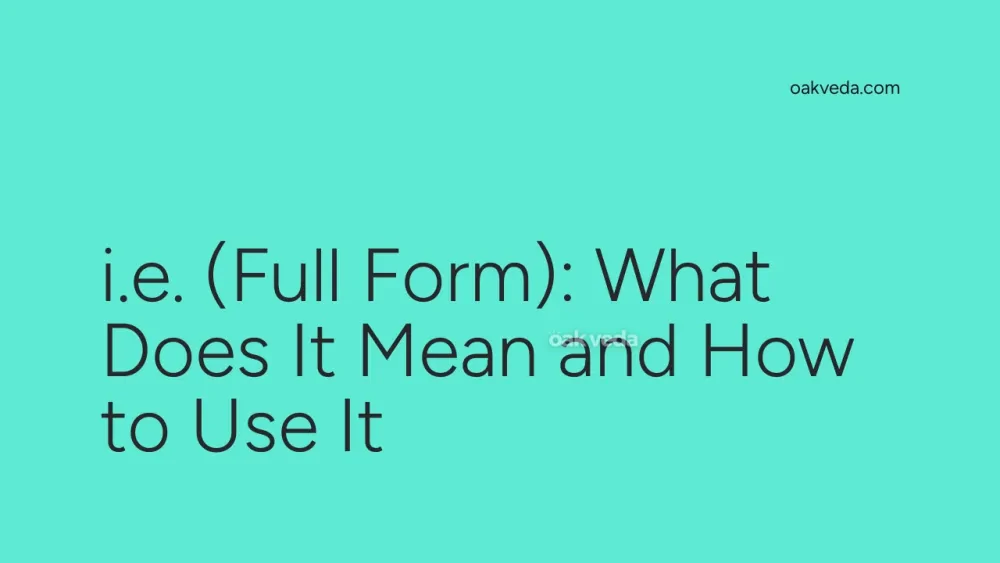
What is the Full Form of i.e.?
The full form of i.e. is "id est," which is a Latin phrase meaning "that is" or "in other words." This abbreviation is commonly used in English writing to provide clarification or to restate information in a more specific way.
What is id est?
"Id est" is a Latin phrase that has been adopted into the English language as a useful tool for writers and speakers. It serves as a way to introduce an explanation or a more precise description of something that has been previously mentioned. In essence, i.e. is used to say "in other words" or "to be more specific."
Origin and Development of id est
The use of "id est" can be traced back to ancient Roman times, where Latin was the primary language of scholarship and formal communication. As Latin spread across Europe and influenced many modern languages, certain phrases and abbreviations, including i.e., were adopted into everyday use.
Over time, the abbreviated form "i.e." became more common in English writing, particularly in academic and formal contexts. Today, it is widely used in various forms of written communication, from scholarly articles to business emails.
How does i.e. work?
When using i.e. in a sentence, it typically follows a comma and precedes an explanation or clarification of the preceding statement. It helps to create a clear connection between a general idea and its more specific meaning. For example:
- "She excels in STEM subjects, i.e., science, technology, engineering, and mathematics."
- "The meeting is scheduled for the end of the quarter, i.e., late March or early April."
Functions of i.e.
The primary functions of i.e. in writing include:
- Clarification: It helps to provide a more precise explanation of a concept or idea.
- Specification: i.e. is used to narrow down a broader statement to its specific components.
- Definition: It can introduce a definition or explanation of a term or phrase.
- Elaboration: i.e. allows writers to expand on a point with additional details.
Applications of i.e.
i.e. is widely used in various forms of writing, including:
- Academic writing: Research papers, essays, and scholarly articles often use i.e. to provide precise explanations.
- Business communication: Emails, reports, and presentations may include i.e. to clarify points or define terms.
- Legal documents: Contracts and legal briefs often use i.e. to specify exact meanings and avoid ambiguity.
- Technical writing: Manuals, specifications, and scientific papers use i.e. to provide accurate descriptions.
- Journalism: News articles and feature stories may employ i.e. to offer readers additional context or explanation.
Features of i.e.
Key features of i.e. include:
- Brevity: It's a concise way to introduce an explanation or clarification.
- Clarity: i.e. helps to make writing more precise and easier to understand.
- Formality: It adds a touch of formality and scholarly tone to writing.
- Versatility: i.e. can be used in various contexts and writing styles.
Benefits of Using i.e.
Incorporating i.e. into your writing can offer several advantages:
- Improved clarity: It helps readers understand complex ideas more easily.
- Conciseness: i.e. allows writers to provide additional information without wordiness.
- Precision: It enables authors to be more specific in their explanations.
- Enhanced readability: By breaking down complex concepts, i.e. can make text more accessible.
- Professional tone: Proper use of i.e. can lend an air of sophistication to your writing.
Limitations or Challenges of Using i.e.
While i.e. is a useful tool, there are some potential drawbacks to consider:
- Overuse: Excessive use of i.e. can make writing feel choppy or overly formal.
- Confusion with e.g.: Some writers mistakenly use i.e. when they mean e.g. (exempli gratia, meaning "for example").
- Punctuation errors: Incorrect punctuation around i.e. can lead to grammatical mistakes.
- Accessibility: Some readers may not be familiar with the abbreviation, potentially causing confusion.
Future Developments in i.e. Usage
As language evolves, so does the use of abbreviations like i.e. Some potential future developments include:
- Increased digital usage: With the rise of digital communication, i.e. may become more common in informal online writing.
- Simplified style guides: Some style guides may recommend using "that is" instead of i.e. for clarity.
- Localization: Non-English speaking countries may adopt their own equivalents or translations of i.e.
FAQs on i.e. Full Form
-
How is i.e. pronounced? It's typically read as "that is" or "in other words" rather than pronouncing the individual letters.
-
Should i.e. be italicized? In most cases, i.e. is not italicized unless the entire sentence is in italics.
-
Is there a difference between i.e. and e.g.? Yes, i.e. means "that is" and is used for clarification, while e.g. means "for example" and is used to provide examples.
-
Can i.e. be used at the beginning of a sentence? It's generally not recommended to start a sentence with i.e. Instead, use "That is" or rephrase the sentence.
-
Is it necessary to use commas with i.e.? Yes, i.e. is typically set off by commas: one before and one after the abbreviation and its accompanying explanation.
By understanding the full form and proper usage of i.e., you can enhance your writing skills and communicate more effectively. Whether you're crafting an academic paper, a business report, or a casual email, mastering this small but powerful abbreviation can significantly improve the clarity and precision of your message.
You may be interested in:

